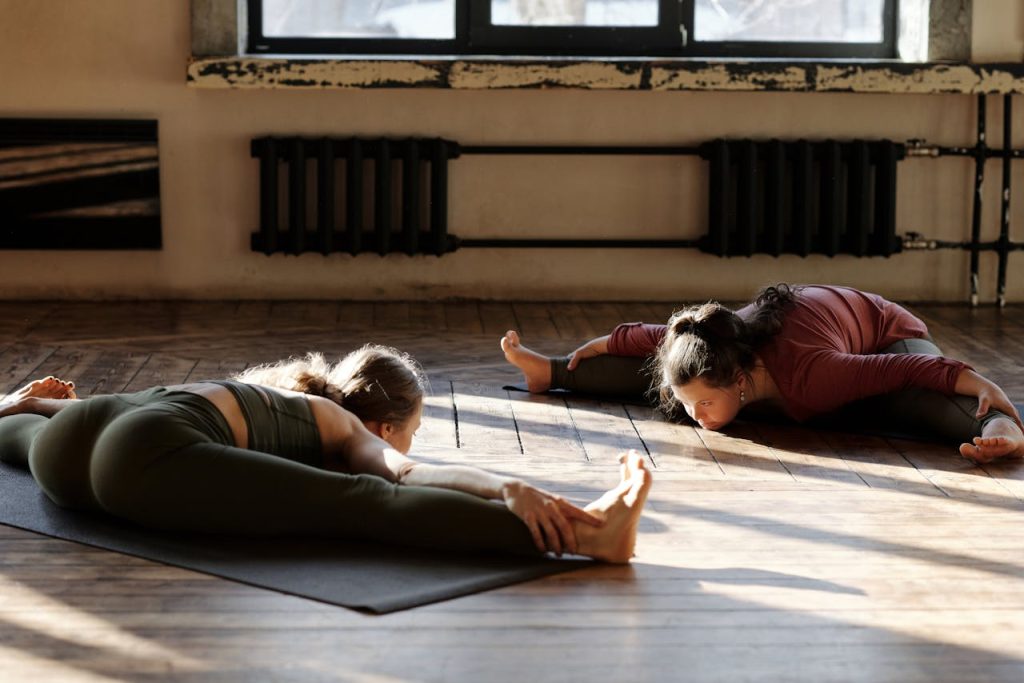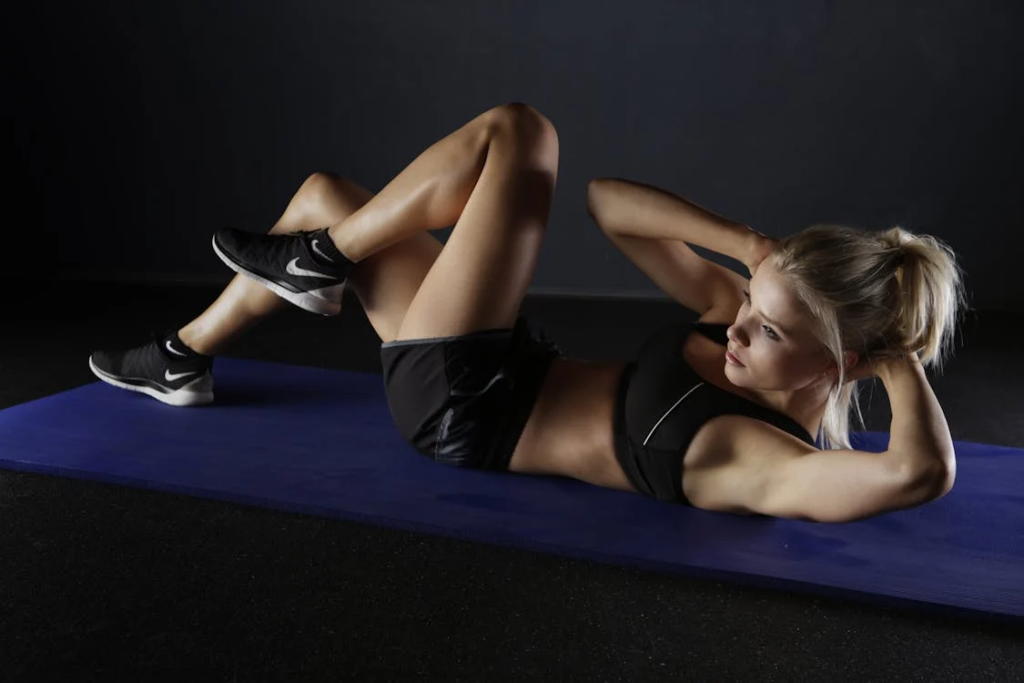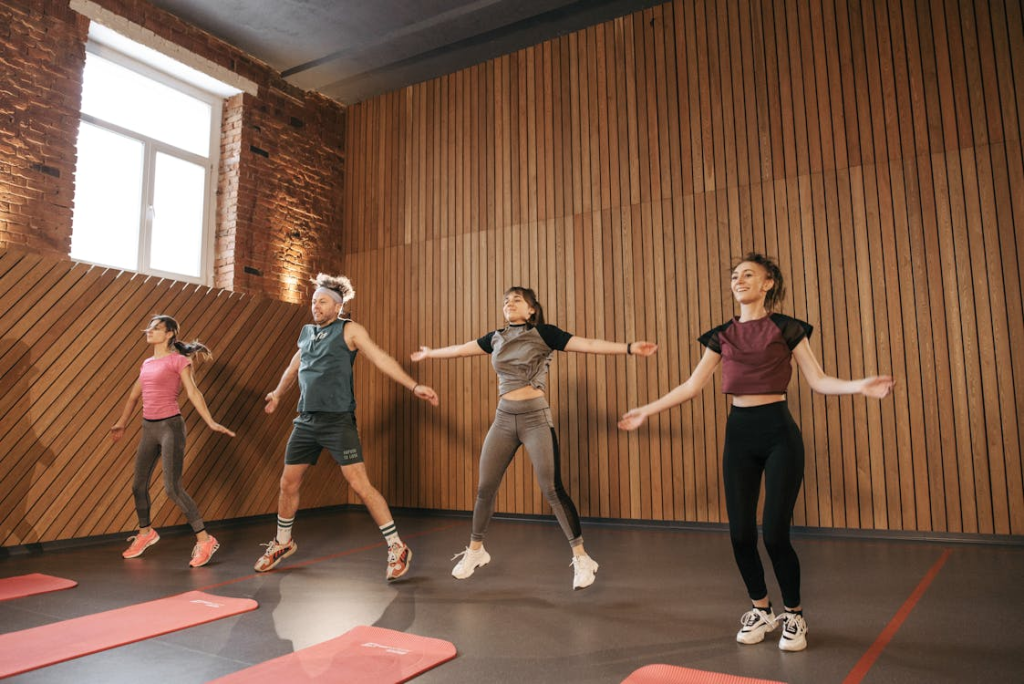Fitness
Best Yoga for Strength and Flexibility: Full Body Practice at Home
Yoga offers a comprehensive approach to fitness by increasing muscle strength and endurance, which is crucial for physical performance.

Yoga stands as a beacon of holistic wellness, amalgamating various physical, mental, and spiritual practices into a serene yet formidable discipline. Within the tapestry of its diverse forms, yoga offers powerful tools for forging strength and flexibility. In this comprehensive guide, we explore the best yoga for strength and flexibility approaches for those looking to fortify their bodies and enhance their suppleness.
Table of Contents
Introduction: The Synergy of Yoga with Body and Mind
Yoga is not just about contorting your body into complex shapes or finding tranquility on a mat. It is a dynamic interplay between strength and flexibility, where each is the poised counterpart to the other. When you practice yoga for strength, you are not just building muscles, you are cultivating endurance and prowess. Similarly, when you seek flexibility through yoga, you do more than just touch your toes; you foster joint longevity and invigorate your being with a fluid vitality.
For those new to the concept, the marriage of strength and flexibility might seem paradoxical. But in the realm of yoga, they are complementary aspects that unfold a path of unparalleled physical and mental growth. The asanas, or poses, that sculpt strength also infuse suppleness. This dualistic approach not only fosters a fitter physique but also encourages longevity in your practice by preventing injury and imbalance.
Strength Through Yoga: The Journey to Muscular Vitality
Finding Your Foundation: Core and Arm Strength
The bedrock of strength in yoga begins with the core. A strong and supportive midsection is the linchpin for many poses, starting with the fundamental ‘Tadasana‘ or Mountain Pose. Poses like Plank, Side Plank, and Dolphin Plank are veritable crucibles that forge ironclad cores. Delving deeper, inversions such as Headstand and Handstand call upon the arms to carry the body’s weight, instilling a robust fortitude in the upper body and beyond.
The Lower Body Lift-offs: Leg and Glute Strength
Yoga postures relentlessly engage the lower body, enhancing the strength and endurance of the legs and glutes. ‘Virabhadrasana‘ or Warrior Poses anchor strength through stances that require balance and resilience. Add to that the deep-knee bends of ‘Utkatasana’ or Chair Pose, and the glutes whisper their newfound might. The beauty of these asanas lies not just in the immediate strengthening benefits but in the subtler methods by which they sculpt and tone.

Harnessing the Force Within: Core Breathing
Conscious breathing or ‘Pranayama’ in yoga invigorates the musculature of the respiratory system, synergizing the act of respiration with the muscles associated with the breath. ‘Ujjayi Pranayama,’ the victorious breath, is a staple in many yoga practices and guides breath control with a tightening and release of the throat muscles that echoes the engagement one might find in strength training. This breathwork is the quintessential bridge between yoga for strength and traditional muscle development.
Flexibility Unveiled: The Elixir of Well-Oiled Joints
From Roots to Tips: Finding Length and Extension
At its heart, flexibility in yoga is the art of mastering one’s range of motion with grace. Each asana serves as a means to elongate and release tension, from the foundational ‘Surya Namaskar‘ or Sun Salutation, which sweeps through the whole body, to the gentle supine stretches of ‘Supta Matsyendrasana‘ or Reclined Spinal Twist, which untwists the knots in the spine with a tender encouragement.
The Hips, The Seat of Resilience and Mobility
Hips can be the barometer of bodily resiliency, and in yoga, the ‘Pigeon Pose‘ is a testament to this. This single pose unlocks immense benefits, not only rending the hip flexors but also the piriformis, an often-neglected gluteal muscle key to lower body alignment. By practicing hip-opening poses like Eka Pada Rajakapotasana or the aforementioned Pigeon Pose, you gradually peel away layers of stiffness to reveal a newfound store of mobility.
Care for the Cradles of Movement: Shoulder and Spinal Flexibility
Yoga extends its gentle coaxing towards the often-neglected shoulder and spine. Through ‘Gomukhasana’ or Cow Face Pose and the intricate twists of ‘Marichyasana,’ you invite greater flexibility in cranial and upper dorsal regions. These stretches are pivotal not only for the health of the spinal cord but also in allowing the shoulders to find their broadness and openness, crucial in maintaining balance and poise throughout your practice.
Poses That Unite Strength and Flexibility in Harmony
The Ascendance of the Warrior Poses
Warrior I, II, and III are exemplars of this harmony; they demand a balance of strength to hold the pose and flexibility to stretch and elongate through the spine and legs. They are also grounding, connecting you to the earth and your innate power.
Bridging the Gap with Urdhva Dhanurasana
The ‘Wheel Pose’ is a potent fusion of backbend—compelling the spine into extension, and arm strengthening—as the arms support the weight of the body. Its benefits ripple through the entirety of your sinews, infusing both power and pliancy.
Finding Stability and Flight in Bakasana
The ‘Crow Pose’ pushes the boundaries of balance, strength, and flexion. While your foundation must be rock solid to support the body’s weight, the legs and arms articulate a symphony of motion that showcases their formidable flexibility and resilience.
Navigating Your Journey With Finesse: Tips for Practice
Begin with a Gentle Warm-Up: The Salutation Ritual
Start your practice with a few rounds of ‘Surya Namaskar’ to awaken the body. These sun salutations are a flowing sequence of poses that serve as a perfect primer for the more demanding postures that will come later in your session.
Breathe Right, Move Right
The breathing is not just a passive observer in yoga; it is the conductor that orchestrates every movement. Maintain a steady ‘Ujjayi’ breath pattern, drawing air in deeply through the nose, letting the breath travel down into the lungs, and exhaling smoothly.
Consistency is Key to Unlocking Progress
Yoga is a cumulative discipline. The flexibility and strength gained from each session are not isolated; they build upon each other. Commit to a regular routine, and over time, the incremental changes will surprise you with a body that is more resilient, agile, and powerful.
Conclusion: The Yogic Odyssey of Power and Grace
Yoga, when approached to cultivate strength and flexibility, leads to a profound integration of full body and mind. It is a voyage of self-exploration, where each pose empowers you to discover new facets of your capabilities. By finding a balance between cultivating strength and nurturing flexibility, you not only forge a more robust physical frame but also lay the groundwork for a more harmonious, agile, and spirited life.
With the knowledge imparted in this guide, you are now equipped to intertwine the threads of strength and flexibility in your yoga practice. As you venture forth on this yogic path, may you find the beauty in the unity of these core tenets, and may your mat be a canvas for the blossoming of your most vibrant, vital self. Keep breathing, keep moving, and embrace the journey with grace and perseverance. The possibilities are endless when you tap into the force that resides within you – harness it, nurture it, and let it guide you towards your highest potential.
Full Body Yoga for Strength & Flexibility | 25 Minute At Home Mobility Routine (Video)
10 Minute Yoga Full Body Stretch for Stiff Bodies (Video)
Best Yoga for Strength and Flexibility FAQ
What are the overall benefits of practicing yoga for strength and flexibility?
Yoga offers a comprehensive approach to fitness by increasing muscle strength and endurance, which is crucial for physical performance. It also significantly boosts flexibility, which can lead to better posture, greater range of motion, and a lower chance of sustaining injuries. Additionally, practicing yoga contributes to improved balance and coordination, which are essential for both daily activities and athletic pursuits. For those looking to manage weight, yoga helps by building lean muscle mass and enhancing metabolic rate. Beyond physical benefits, yoga is known for its mental advantages too, such as reducing stress levels and cultivating a stronger sense of focus through the combination of movement and controlled breathing.
Which yoga poses are most effective for gaining strength?
For building strength, particularly in the arms, shoulders, legs, and core, poses like Plank Pose and Warrior II are highly effective. Plank Pose challenges your entire body, engaging the core and upper body muscles, while Warrior II focuses on the legs, glutes, and arms. Consistent practice of these poses can lead to stronger and more defined muscles.
Can yoga improve flexibility if I’m not naturally flexible?
Absolutely. Yoga is an excellent practice for increasing flexibility, regardless of your starting point. Poses such as Downward Dog and Tree Pose are accessible to beginners and can be modified to suit various levels of flexibility. Regular yoga practice can gradually lengthen and stretch muscles and improve joint mobility, making it a suitable discipline for anyone looking to enhance their flexibility.
How often should I practice yoga to see improvements in strength and flexibility?
While the frequency of your yoga practice can vary based on your individual schedule and goals, a consistent routine is key. Practicing 2-3 times a week is a good start for gradual improvement, while more frequent sessions can accelerate progress. However, it’s important to listen to your body and allow time for recovery, as rest is essential for muscle growth and healing.
Do I need to attend yoga classes, or can I practice at home for strength and flexibility?
While attending classes can be beneficial, especially for beginners who may require guidance on form and technique, it is not necessary to go to a studio. There are many resources available such as online videos, apps, and books that provide instruction for a home practice. Whether at home or in a studio, regular and mindful practice is what contributes most to gaining strength and flexibility.
Are there specific types of yoga that are best for building strength and flexibility?
Yes, certain types of yoga are particularly geared towards improving strength and flexibility. For instance, Vinyasa or Power Yoga are dynamic and physically demanding styles that can enhance muscle strength and flexibility. Iyengar Yoga, known for its use of props and emphasis on alignment, is also excellent for building strength and improving flexibility safely. It’s beneficial to explore different styles and find the one that best suits your needs and preferences.
Fitness
6 Quick Morning Exercises to Burn Belly Fat All Day

Want to kickstart your day with energy, confidence, and a flatter stomach? Adding a short, targeted workout to your morning routine could be your secret weapon. These morning exercises to burn belly fat are simple, require no gym equipment, and take just 10–15 minutes. Best of all, they activate your metabolism, helping you torch fat all day long.
🔥 Why Morning Workouts Help Burn Belly Fat
When you exercise first thing in the morning, you wake up your metabolism and prime your body for all-day fat-burning. Studies have shown that morning workouts can:
- Increase fat oxidation
- Suppress appetite hormones
- Improve insulin sensitivity
- Boost overall energy levels
Let’s dive into six expert-approved exercises that are especially effective at targeting stubborn belly fat.
1. 🏃♂️ Jumping Jacks
A powerful, full-body warm-up that gets your heart rate up and prepares your body for fat-burning mode.
How to do it:
- Stand with your feet together and arms by your sides.
- Jump while spreading your legs and lifting arms overhead.
- Jump back to the starting position and repeat for 30–60 seconds.
Benefits: Activates your cardiovascular system, burns calories fast, and wakes up your body.

2. 🦵 Mountain Climbers
This core-focused cardio exercise engages your abs, obliques, and lower body, helping melt away midsection fat.
How to do it:
- Get into a high plank position.
- Drive your right knee toward your chest, then switch legs in a running motion.
- Maintain a steady rhythm for 30 seconds.
Pro Tip: Keep your back flat and core tight to avoid injury.
3. 🧘 Plank to Push-Up
This compound move strengthens your core and upper body while improving stability and burning fat.
How to do it:
- Start in a forearm plank position.
- Press up onto your hands one at a time, coming into a high plank.
- Lower back down to your forearms.
- Continue alternating for 30 seconds.
Targets: Abs, shoulders, triceps, and chest.
4. 🔁 Bicycle Crunches
One of the most effective abdominal exercises for flattening the belly and building definition.
How to do it:
- Lie flat on your back with hands behind your head.
- Lift your shoulders off the floor and bring one knee toward your chest.
- Twist your torso to touch the opposite elbow to the knee.
- Alternate sides in a pedaling motion.
Duration: 30–45 seconds.

5. 🧍 Squat Jumps
This explosive movement builds lower-body strength and burns a significant amount of calories quickly.
How to do it:
- Stand with your feet shoulder-width apart.
- Lower into a squat, then jump straight up, extending your arms overhead.
- Land softly and go right into the next squat.
Muscles worked: Glutes, hamstrings, calves, core.
6. 🧍♀️ Standing Oblique Crunch
This simple, equipment-free move helps tighten your sides and strengthen your core.
How to do it:
- Stand with your hands behind your head.
- Raise your right knee toward your right elbow as you bend to the side.
- Return to center and repeat on the left side.
- Do 15 reps per side.
Bonus: It’s gentle enough for beginners but effective enough for regulars.
🕒 Sample 10-Minute Fat-Burning Morning Routine
- Jumping Jacks – 60 seconds
- Mountain Climbers – 30 seconds
- Plank to Push-Up – 30 seconds
- Bicycle Crunches – 45 seconds
- Squat Jumps – 30 seconds
- Standing Oblique Crunch – 60 seconds
Rest 1 minute and repeat.
✅ Tips for Success
- Perform exercises on an empty stomach or light snack (if needed).
- Stay consistent—try at least 4 mornings per week.
- Pair your workouts with a clean, protein-rich breakfast.
- Track your progress and adjust intensity as you improve.
💡 Final Thoughts
These six morning exercises to burn belly fat don’t require fancy equipment or hours in the gym. They can be completed at home in just 10–15 minutes, making them perfect for busy schedules. Add them to your morning routine, stay consistent, and start seeing results in your energy levels and waistline.
📌 Related Posts
Fitness
Transform Your Health in Just 5 Minutes a Day: The Power of Eccentric Exercises

In today’s fast-paced world, finding time for fitness can be challenging. However, recent research from Edith Cowan University reveals that dedicating just five minutes daily to simple eccentric exercises can significantly enhance strength, flexibility, and mental well-being—even for those leading sedentary lifestyles.
What Are Eccentric Exercises?
Eccentric exercises focus on the muscle-lengthening phase of movement. This involves controlled, slow motions where muscles are engaged while extending. Common examples include:
- Chair Squats: Slowly lowering into a seated position without actually sitting.
- Chair Reclines: Gradually leaning back towards a chair, engaging core muscles.
- Wall Push-Ups: Performing push-ups against a wall, emphasizing the lowering phase.
- Heel Drops: Standing on tiptoes and slowly lowering heels below the step level.
These movements are low-impact, require no special equipment, and can be performed anywhere, making them accessible to all fitness levels.
The Study: Small Effort, Significant Gains
The study involved 22 healthy but inactive adults aged between 32 and 69. Participants performed 10 repetitions of the aforementioned exercises daily for four weeks. Findings included:
- Improved muscle strength and endurance.
- Enhanced flexibility.
- Better performance in functional fitness tests like sit-ups and step tests.
- Positive impacts on mental health and mood.
Notably, these benefits were achieved without significant changes in body composition or traditional physiological markers, highlighting the profound impact of consistent, minimal effort.
Why Eccentric Exercises Work
Eccentric movements are energy-efficient and place less strain on the body compared to other exercise forms. They are particularly beneficial for older adults, aiding in combating age-related muscle loss. Additionally, these exercises engage the brain more intensely, potentially offering cognitive benefits.
Getting Started: Tips for Success
- Start Slow: Begin with 10 repetitions of each exercise, focusing on controlled movements.
- Consistency is Key: Aim for daily practice, even if it’s just five minutes.
- Listen to Your Body: Ensure movements are comfortable; adjust as needed.
- Progress Gradually: As strength improves, consider increasing repetitions or incorporating more challenging variations.
Final Thoughts
Incorporating just five minutes of eccentric exercises into your daily routine can lead to significant improvements in strength, flexibility, and mental well-being. This approach offers a practical, accessible solution for those seeking health benefits without extensive time commitments or gym memberships.
Ready to start? Embrace these simple movements today and take the first step towards a healthier, more active lifestyle.
Fitness
Healthy Meal Prep for Weight Loss: Simple Strategies to Save Time and Eat Healthy All Week
The struggle between saving time and sticking to a healthy diet can leave even the most resolved health enthusiast feeling discouraged. But fear not! Meal prep is your secret weapon to save time and take control of your meals with precision.

Are you juggling a busy schedule while attempting to lose weight? The struggle between saving time and sticking to a healthy diet can leave even the most resolved health enthusiast feeling discouraged. But fear not! Meal prep is your secret weapon to save time and take control of your meals with precision. Now, we’ll walk you through the intricacies of healthy meal prep for weight loss, providing you with a step-by-step roadmap to easily integrate this powerful practice into your routine.
Table of Contents
1. Understanding the Meal Prep Revolution
Maintaining weight loss is a challenge in our fast-paced culture, with convenience often trumping health. Feeding into this, research often points to the adverse effects of hectic lifestyles on our dietary habits. However, meal prep provides a systematic approach to overcome these hurdles. By carving out dedicated time each week to plan, prepare, and portion your meals, you can avoid the pitfalls of impulsive and unhealthy eating.
The benefits are numerous: you’ll not only save time during the week but also gain insight into your caloric intake, break free from the grip of fast food, and significantly reduce food waste.
The Math Behind It
At its core, weight loss is often a numbers game—calories in versus calories out. Setting clear and attainable goals for your daily caloric consumption and understanding your weight loss target is pivotal. Meal prep ensures a level of control over what you consume, as you’ve already planned and portioned your meals to align with your objectives.
Recipes That Resonate
Meal planning should be richly rewarding, not a mundane chore. Bursting with a myriad of flavorful and healthy recipes ensures that your meals are not only fulfilling but also excite the palate, making healthy eating a joyful experience. Diversifying your recipes across food groups is not only nutritionally sound but also staves off the boredom associated with monotonous diets.
Tools of the Trade
Equipping your kitchen with the right tools makes the meal prep process a smooth ride. From quality storage containers and portioning aids to efficient cooking implements, the right gadgets are your silent sous-chefs. And don’t forget the most important tool—organization. Ensuring your kitchen is set up efficiently for a meal prep session is a critical component of success.
Timing Is Everything
Consistency is key to any successful habit, and meal prep is no different. Choose a day and time that fits your schedule each week, and stick to it. Mark it on your calendar, set reminders, and make it an inviolable commitment.
Storing Your Treasure Trove
Proper storage of your prepared meals is a non-negotiable part of the process. Utilize the right containers, and consider labeling to safeguard against confusion and maintain meal freshness. For meals you may not consume within a few days, freezing can extend their shelf life and prevent spoilage.
2. Mastering the Art of Healthy Meal Prep for weight loss
Planning your meals for a week can seem daunting, but breaking the process into manageable steps makes it achievable and sets you up for a smooth execution.
Step-by-Step Meal Prep Guide
- Select Your Recipes Wisely – Pick recipes that are not only healthy but also align with your taste preferences and time constraints.
- Make a Detailed Shopping List – A list based on your chosen recipes will keep you on track at the store. Remember, the key to a successful shopping trip is sticking to your list and avoiding aisles that house temptations.
- Prep Your Ingredients – Wash, chop, and portion your ingredients in advance for streamlined assembly when the meal prep day arrives.
- Cook Like a Pro – Utilize batch cooking for dishes that freeze well or can be refrigerated for several days. Think of meals that reheat beautifully and retain their texture and flavor.
- Portion Like a Champion – Portion out your meals according to your caloric needs. This not only simplifies tracking but also ensures you’re not overeating.
- Label Everything – Clearly mark each container with the meal type and date prepared. This step is often overlooked but is crucial for maintaining food safety and organization.
- Store Safely – Store your prepped meals appropriately in the refrigerator or freezer, and make sure to follow recommended safety guidelines to prevent spoilage and food-borne illnesses.
Meal Prep Tips and Tricks
- A Fruitful Endeavor – Prepare fresh fruit salads and cut-up veggie sticks for easy snacking. Fruit and vegetables are essential for a balanced diet and complement any weight loss regimen.
- The Power of Leftovers – Get creative with repurposing leftovers. For example, a roasted chicken can provide protein for lunch salads or sandwich fillings.
- Family Focus – Get everyone involved. Engaging your family in the meal prep process can turn a solitary activity into a bonding experience. It’s also a great way to teach children about nutrition and kitchen skills.

3. Healthy Meal Prep Recipes for Weight Loss:
Here are a few recipe ideas to get you started with your weight loss meal prep journey. These recipes prioritize protein, whole grains, vegetables, and healthy fats, keeping you satisfied and fueled throughout the week.
Breakfast (Single Serving):
- Overnight Oats with Berries and Chia Seeds: Combine rolled oats, Greek yogurt, chia seeds, milk (dairy or non-dairy), and a touch of honey in a mason jar. Refrigerate overnight for a grab-and-go breakfast packed with protein and fiber. Top with fresh berries before eating.
Lunch (Single Serving):
- Mediterranean Chickpea Salad: Combine cooked chickpeas, chopped cucumber, cherry tomatoes, crumbled feta cheese, Kalamata olives, and a lemon vinaigrette dressing. Serve on a bed of romaine lettuce or whole-wheat pita bread.
Dinner (Single Serving):
- Salmon with Roasted Vegetables: Bake salmon fillets seasoned with herbs and spices alongside chopped broccoli, asparagus, and sweet potato wedges. Drizzle with olive oil and roast until the vegetables are tender and the salmon is flaky.
Snacks (Single Serving):
- Hard-boiled Eggs: A classic protein snack, hard-boiled eggs are easy to prepare in advance and keep well throughout the week.
- Carrot Sticks with Hummus: Pair baby carrots with a portion of hummus for a satisfying and crunchy snack.
- Apple Slices with Almond Butter: Sliced apples with almond butter provide a delicious balance of sweetness and healthy fats.
Bonus Recipe (Serves 4):
- Turkey Taco Bowls: Brown ground turkey with taco seasoning. In separate containers, prep chopped lettuce, diced tomatoes, shredded cheese, sliced avocado, salsa, and cooked brown rice. Assemble individual bowls with the desired toppings and enjoy a healthy and customizable taco meal prep.
Tips for Healthy Meal Recipes:
- Double or triple these recipes to create enough portions for the entire week.
- Utilize pre-cut vegetables or frozen ingredients to save time on chopping.
- Choose lean protein sources like chicken, fish, or tofu.
- Opt for whole grains like brown rice or quinoa instead of refined carbohydrates.
- Season your meals with herbs and spices for added flavor without extra calories.
- Remember to label your containers with the contents and date of preparation.
4. The Psychological Impacts of Meal Prep
Implementing a regimen like meal prep does more than just streamline your week—it can have powerful psychological impacts that can support your weight loss efforts.
Temptation Tamed
Perhaps the most immediate psychological benefit of meal prep is the successful avoidance of tempting, calorie-dense foods. Knowing that you have a healthy, satisfying meal awaiting you reduces the allure of impulse eating.
Routine Reinforcement
Humans are creatures of habit, and by making meal prep part of your weekly routine, you reinforce the habit of mindful eating and self-care. This predictability can alleviate some of the stress associated with not knowing where your next meal will come from—birthing mindfulness and presentness during mealtimes.
Control and Choice
Meal prep empowers you to make thoughtful choices about what you put into your body. This regained sense of control over your diet can be incredibly liberating, setting the stage for you to progress toward your weight loss goals with confidence.
5. Crafting a Meal Plan That Works for You
A meal plan is like a personal trainer for your diet—it keeps you on track and accountable. But creating a plan that’s not only effective but sustainable is an art. Here are some tips to craft a meal plan that is tailored to you.
It’s Not Cookie-Cutter
Resist the urge to adopt a one-size-fits-all meal plan. What works for a friend or a celebrity isn’t guaranteed to work for you. Take into account your dietary restrictions, lifestyle, and personal goals when crafting your plan.
Mind the Habits
Take an honest inventory of your current eating habits when creating your meal plan. Identify any red flags or areas for improvement and design your plan to address these patterns.
Balance and Moderation
A balanced diet is one that provides your body with the nutrients it needs to function correctly. Moderation is the key to sustainability. Ensure your meal plan isn’t too restrictive, and leave a little room for occasional indulgences.
6. The Long-Term Benefits of Meal Prep for Weight Loss
The arsenal of benefits that come with adopting a meal prep strategy extends far beyond the simple convenience it offers. For those on a weight loss journey, these long-term benefits can make a significant difference.
Savor the Savings
Batch cooking on a larger scale means you can take advantage of groceries bought in bulk and at less expensive sources, saving money in the long run.
Mastery Over Macros
When you prepare your own meals, you have complete control over what you eat. This control extends to macronutrients, simplifying the process of fitting them into your daily targets.
A Tasteful Transformation
The satisfaction that comes from craftily prepared meals that can be both healthy and delectable can redefine your relationship with food. Gone are the days of tasteless diet foods—the options are as endless as your imagination.
Time Is on Your Side
The most obvious benefit, perhaps, is the time saved during the week. No more last-minute rushes to prepare a meal. Instead, your week is rounded out with the satisfaction of time-saving, nutritionally sound meals.
7. Conclusion
The penultimate section will reinforce the positive impact of meal prep on weight loss and overall well-being. Benefits such as refined portion control, enhanced nutrition, and the liberating sense of time and financial savings are highlighted. Encouragement is woven throughout, steering readers towards adopting meal prep not as a temporary fix, but as a sustained and joyful part of their lifestyle. The message of the section is clear – meal prep can be a game-changer for anyone seeking long-term health transformations.
8. Call to Action
We will round off by urging readers to take the next step in their healthy living journeys. Pragmatic calls to action, including links to additional recipes and a call to share experiences, will enhance engagement and demonstrate that the relationship between meal prep and readers is a two-way street. This interaction will cement the ideas presented as not just advice but as a collaborative exploration of the path to holistic health.
This meticulous approach to content organization ensures that readers are guided seamlessly through the process of meal prep, establishing a sense of trust and authority in the advice provided. It incorporates the balance of creativity and structure necessary for engaging and informative content that stands the test of time.
Video Story for Meal Prep for Weight Loss
FAQ
Is meal prep really worth the time investment?
Absolutely! While it may take a dedicated chunk of time upfront, meal prep saves you precious minutes throughout the week. No more scrambling to decide what to eat, and no more unhealthy temptations when you’re short on time. Plus, portion control becomes a breeze!
I’m a newbie cook. Can I still do meal prep?
Yes! Meal prep is perfect for all skill levels. Focus on simple recipes with minimal ingredients. Many websites and cookbooks offer “meal prep for beginners” options. Utilize tools like slow cookers, sheet pans, and pre-cut vegetables to simplify the process.
How long will my prepped meals stay fresh?
Proper storage is key. Generally, cooked meals stored in airtight containers will last 3-4 days in the refrigerator. If you’re prepping for the entire week, consider freezing some portions. Just be sure to thaw them properly before reheating.
What are some tips to avoid getting bored with the same meals?
Variety is key! Plan meals with different flavors and textures throughout the week. Leftovers can be repurposed! Use leftover grilled chicken in a salad or stir-fry. Experiment with different herbs and spices to add flavor variety.
-

 Personal Care7 months ago
Personal Care7 months agoWhy Regular Massages Could Be the Game-Changer Your Body and Mind Crave
-

 Mental Health6 months ago
Mental Health6 months agoHow to Overcome Phobias: 15 Positive Psychology-Based Strategies That Really Work
-

 Lifestyle6 months ago
Lifestyle6 months agoWhen Is It Time To Get a Divorce? Emotional, Mental & Practical Signs to Know
-

 Fitness6 months ago
Fitness6 months ago6 Quick Morning Exercises to Burn Belly Fat All Day
-

 Lifestyle6 months ago
Lifestyle6 months agoHow to Improve Egg Quality for Fertility: Science, Lifestyle and Expert Tips
-

 Mental Health7 months ago
Mental Health7 months agoWhat Is A Depression Attack? Symptoms, Causes & How To Cope With One
-

 Food6 months ago
Food6 months agoHealthy Rice Varieties: Nutrition and Health Benefits
-

 Personal Care6 months ago
Personal Care6 months agoHow to Reparent Your Inner Child: Healing and Self-Compassion


Pingback: Benefits of Outdoor Exercise: Fit with Nature